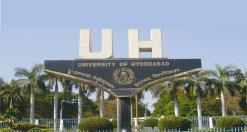






|
Current research activities are directed towards polymorphism, pharmaceutical cocrystals, design and synthesis of solid-state assemblies Polymorphism and pseudopolymorphism. Host-guest inclusion chemistry. Design of novel crystalline solids. Hydrogen bonding and inter-halogen bonding. Thermal measurements on polymorphs. Pre clinical testing of drug cocrystals and eutectics.
To characterize these solids we use single crystal X-ray diffraction, powder XRD, differential scanning calorimetry (DSC), thermal gravimetric analysis (TGA), hot stage microscopy (HSM), TG- IR, TG-MS, NIR, Far IR, Raman Spectroscopy etc. To determine the stability, solubility and dissolution behavior of APIs and API cocrystals we use Humidity chamber, UV-Vis spectroscopy, Dissolution apparatus etc. Supramolecular chemistry and Crystal engineering: Supramolecular chemistry is chemistry beyond the molecule. Conventional chemistry deals with covalent bonds while supramolecular chemistry examines the weaker and reversible non-covalent interactions like hydrogen bonding, metal coordination, hydrophobic forces, van der Waals forces, π-π interactions and electrostatic effects between the molecules. The study of non-covalent interactions has got immense importance in biological systems. Crystal engineering is defined as the understanding of intermolecular interaction in the context of crystal packing and in the utilization of such understanding in the design of new solids with desired physical and chemical properties. Crystal engineering is the construction of crystalline materials from molecules or ions using non-covalent interactions. It deals with the self assembly of both organic and inorganic system: molecular crystals, nanostructures metal-organic frameworks and coordination polymers. Crystal Engineering-Inclusion Compounds, Molecular Networks, Cocrystals and Polymorphs (Perspective). A. Nangia Cryst. Growth Des., 2008, 8, 1079. Variable-Temperature Powder X-ray Diffraction of Aromatic Carboxylic Acid and Carboxamide Cocrystals. L. Sreenivas Reddy , P. M. Bhatt , R. Banerjee , A. Nangia and G. J. Kruger, Chem. Asian Journal., 2007, 2, 505. Carboxamide-pyridine N-oxide heterosynthon for crystal engineering and pharmaceutical cocrystals. L. S. Reddy, N. J. Babu and A. Nangia Polymorphism: The ability of a molecule to crystallize in different crystalline forms is known as polymorphism. Polymorphism in organic solids is of fundamental importance because of its ability to alter physical and chemical properties in different crystal structures, such as melting point, density, compressibility, solubility, hardness, dipole moment and bioavailability. Understanding the origin of polymorphism and controlling the outcome of crystallization process to avoid undesired forms is a current goal in crystal engineering. Getting the right polymorph is not only important for drugs and pharmaceuticals but also for chemicals like explosives, dyes, pigments, flavors and confectionery products. This approach enables emerging strategies to speed-up pharmaceutical development and capture solid form diversity of pharmaceutical substances. Conformational and synthon polymorphism in furosemide (Lasix). N. J. Babu, S. Cherukuvada, R. Thakuria, A. Nangia. Cryst. Growth Des, 2010, 10, 1979-1989 Conformational Polymorphism in Organic Crystals. A. Nangia Acc. Chem. Res., 2008, 41, 595. Kinetic and thermodynamic conformational polymorphs of bis(p-tolyl)ketone p-tosylhydrazone. The Curtin-Hammett principle in crystallization. S. Roy and A. Nangia Cryst. Growth Des., 2007, 7, 2047. Polymorphs of 1,1-bis(4-hydroxyphenyl)cyclohexane and multiple Z crystal structures by melt and sublimation crystallization. B. Sarma, S. Roy and A. Nangia Conformational, Concomitant Polymorphs of 4,4-Diphenyl-2,5-cyclohexadienone:Conformation and Lattice Energy Compensation in the Kinetic and Thermodynamic Forms. S. Roy, R. Banerjee, A. Nangia and G.J. Kruger Chem. Eur. J., 2006, 12, 3777. Neutral and Zwitterionic Polymorphs of 2-(p-Tolylamino) nicotinic Acid. Naba K. Nath, S. Sudalai Kumar, and Ashwini Nangia, Crystal Growth & Design, 2011, 11, 4594-4605. Crystal Structure of Methyl Paraben Polymorph II Naba K. Nath, Himanshu Aggarwal, and Ashwini Nangia, Cryst. Growth Des., 2011, 11, 967-971 Pentamorphs of Acedapsone Geetha Bolla , Sudhir Mittapalli , and Ashwini Nangia, Cryst. Growth Des., 2014, 14, 5260-5274. Pharmaceutical Cocrystals: A cocrystal may be defined as a multi-component crystal in which two or more molecules that are solid under ambient condition coexist through hydrogen bonds. Definition of cocrystal can be made flexible to accommodate solvent (liquid) or gas as the second (third) component and the supramolecular interaction be not limited to hydrogen bonds but include other intermolecular interactions, e.g. halogen bonds, π-π stacking or any other non-covalent interactions. Cocrystals that are formed between an Active Pharmaceutical Ingredient (API) and a non-toxic chemical or GRAS (Generally Regarded As Safe) molecule to the human body is called as Pharmaceutical cocrystals. Several problems encountered in pharmaceutical industries with APIs, in terms of their solubility, dissolution rates, and stability can be surmounted without the need to make or break covalent bonds of the drug molecule by making appropriate cocrystal. Polymorphs and Polymorphic Cocrystals of Temozolomide. N. Jagadeesh Babu, L. Sreenivas Reddy, Srinivasulu Aitipamula, and Ashwini Nangia. Chem. Asian Journal., 2008, 3, 1122. The Role of π-Stacking in the Composition of Phloroglucinol and Phenazine Cocrystals B. Sarma, L. S. Reddy and A. Nangia Cryst. Growth Des., 2008, 8, 4546. Amide-N-Oxide Heterosynthon and Amide Dimer Homosynthon in Cocrystals of Carboxamide Drugs and Pyridine N-Oxides. N. Jagadeesh Babu, L. Sreenivas Reddy, and A. Nangia, Mol. Pharmaceutics; 2007, 4, 417. Acemetacin cocrystals and salts: structure solution from powder X-ray data and form selection of the piperazine salt Palash Sanphui, Geetha Bolla, Ashwini Nangia* and Vladimir Chernyshev*. IUCrJ, 1, 136-150 Solubility Advantage of Tenoxicam Phenolic Cocrystals Compared to Salts Geetha Bolla , Palash Sanphui , and Ashwini Nangia *, Cryst. Growth Des., 2013, 13 (5), pp 1988-2003 Andrographolide: solving chemical instability and poor solubility by means of cocrystals. Suresh K, Goud NR, Nangia A. Chem Asian J. 2013, 12, 3032-41 Modulating the solubility of sulfacetamide by means of cocrystals N. Rajesh Goud, Ronaq Ali Khan and Ashwini Nangia* CrystEngComm, 2014,16, 5859-5869. Celecoxib cocrystal polymorphs with cyclic amides: synthons of a sulfonamide drug with carboxamide coformers Geetha Bolla, Sudhir Mittapalli and Ashwini Nangia* CrystEngComm, 2014,16, 24-27 Host guest chemistry & Supramolecular Networks: The inclusion of small guest molecules in open framework of a host molecule constitutes a host guest compound. Cavitands, or molecular host compounds with intra-molecular cavities; Clathrands are hosts with extra-molecular cavities that result from the aggregation of more than one molecule are two major categories of host guest chemistry. The rational construction of novel open-framework of organic solids is of particular interest because of their diverse applications such as chemical separation, reactions and catalysis in a microcavity, and for electro-optic, nonlinear and magnetic materials. Metal-ligand coordination bonding is extensively used in the modular assembly of extended porous solids and low density frameworks. Tuning the pore size and shape and controlling the hydrophobic/hydrophilic nature of the host cavity are major endeavors in crystal engineering. Supramolecular networks of a H-shaped aromatic phenol host. R. Thakuria, B. Sarma, A. Nangia. New J. Chem., 2010, 34, 623-636 Guest Control in the Self-assembly of H-shaped Host to Cyclopentanoid (5,34) Net. R. Thakuria, B. Sarma and A. Nangia Cryst. Growth Des., 2008, 8, 1471. Tetrakis,4-sulfophenylmethane dodecahydrate. Reversible and selective water inclusion and release in an organic host. B. Sarma and A. Nangia First example of an ice-like water hexamer boat tape structure in a supramolecular organic host. B. K. Saha, A. Nangia Guest-Induced Supramolecular Isomerism in Inclusion Complexes of T-Shaped Host 4,4-Bis(4'-hydroxyphenyl) cyclohexanone. S. Aitipamula, A. Nangia |